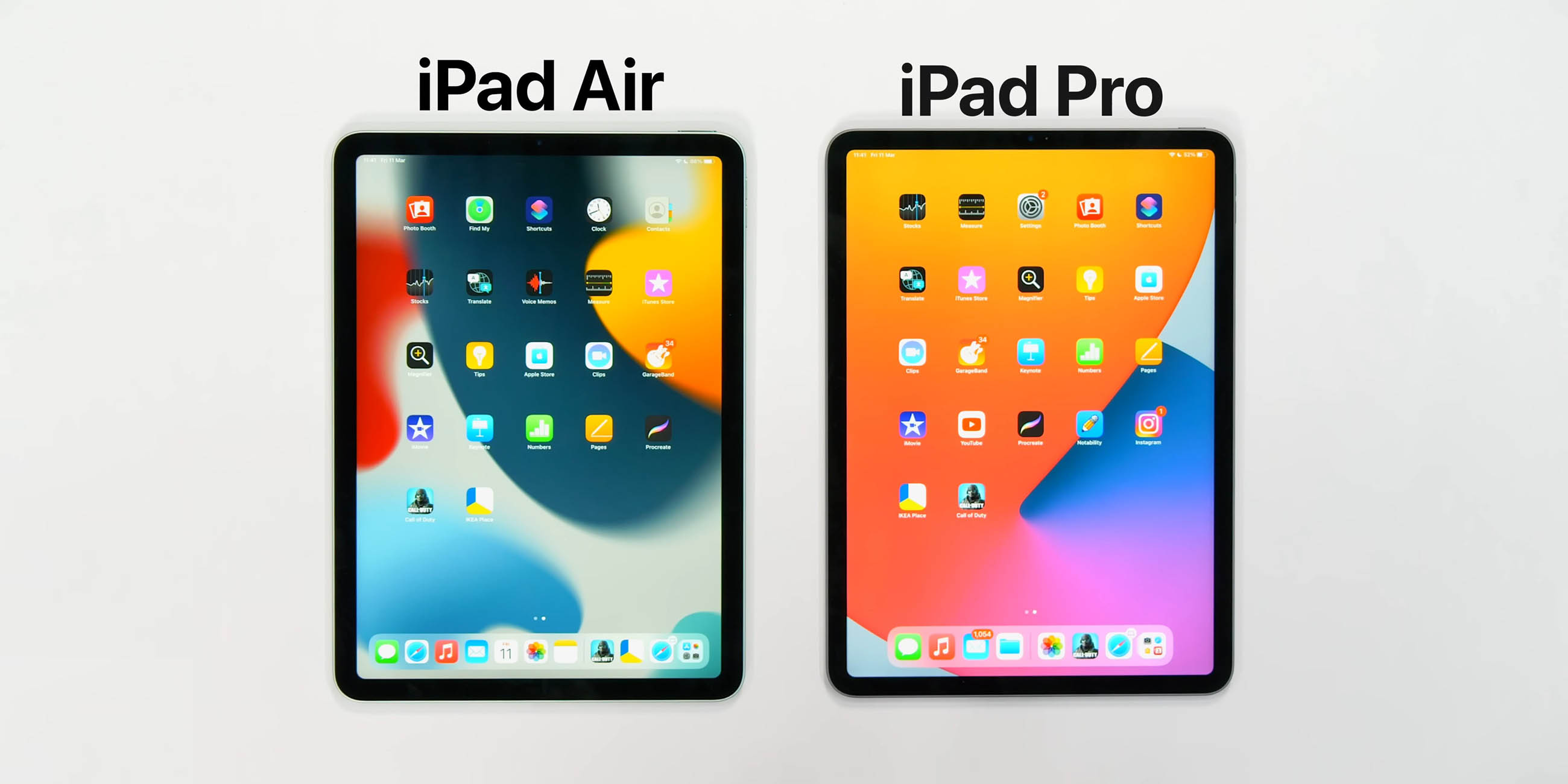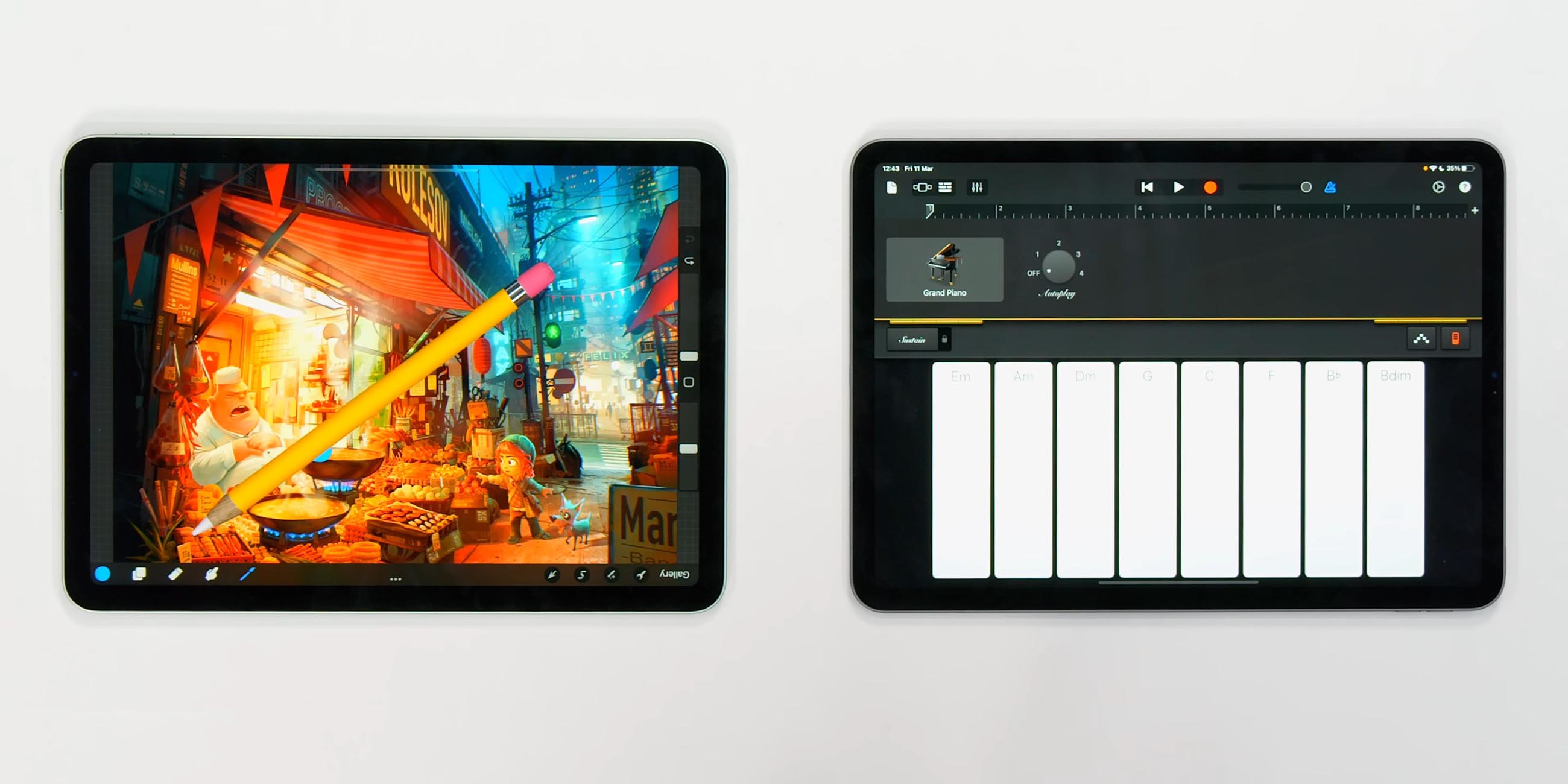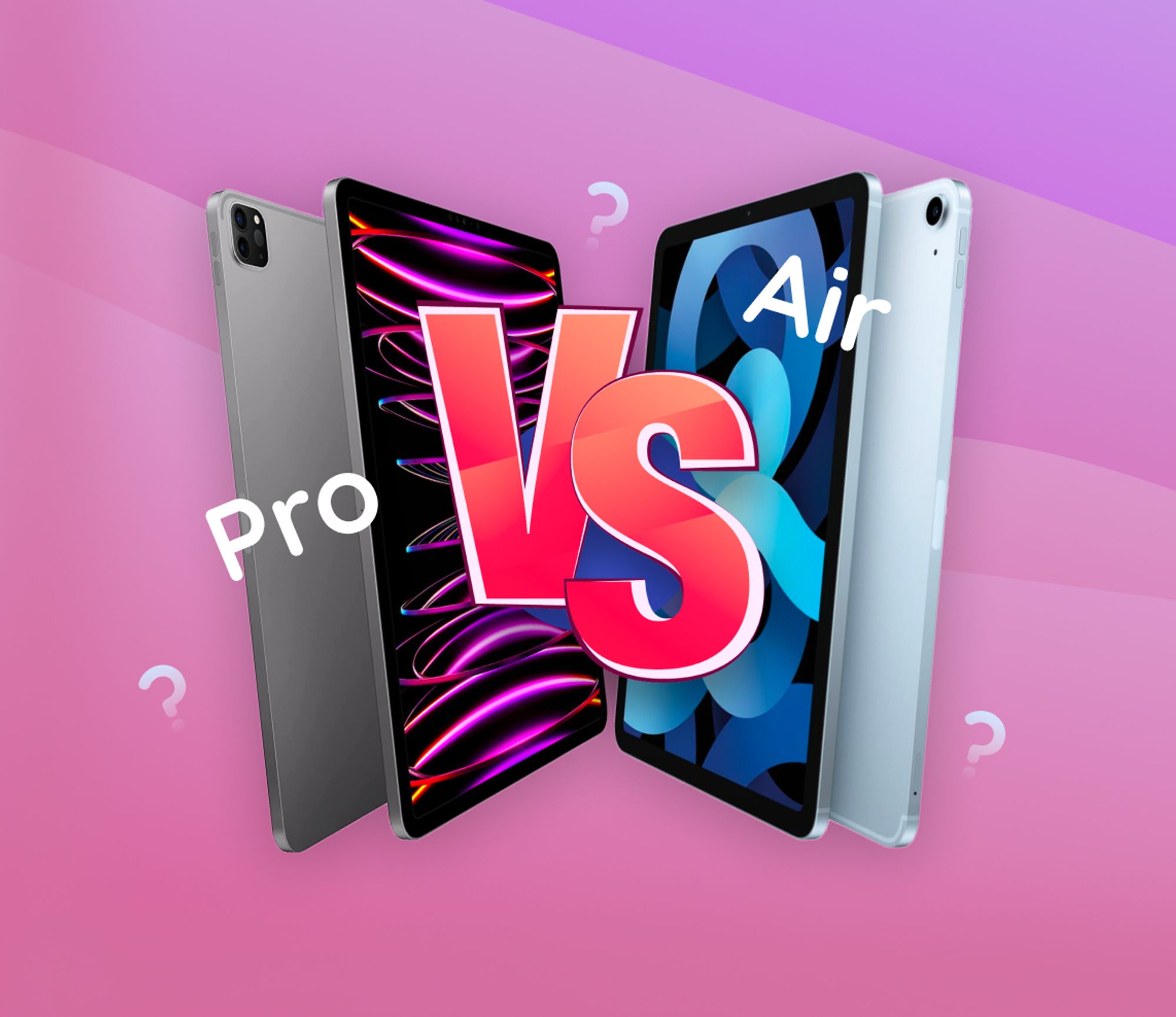In the world of tablets, Apple’s iPad Pro and iPad Air stand out as two prominent contenders. When choosing between them, understanding their key differences in design, performance, productivity features, and connectivity options is essential. This article provides an in-depth comparison of the iPad Pro and iPad Air, examining their physical design, display technologies, processing power, productivity tools, and connectivity capabilities. By the end, you’ll have a clear understanding of which iPad suits your needs, whether you’re a student, professional, or casual user. Let’s dive into the world of iPads and explore their unique offerings.
Design and Display
When comparing the iPad Pro and iPad Air, it’s important to consider their physical design and display characteristics. These factors play a significant role in determining the overall user experience and suitability for different tasks. Let’s explore the key design differences and display technologies used in both models.

Design Differences
The iPad Pro and iPad Air exhibit distinct design elements that set them apart. While both devices feature a sleek and modern aesthetic, the iPad Pro embraces a more professional and premium feel, catering to power users and creative professionals. On the other hand, the iPad Air offers a more versatile and lightweight design, making it suitable for a wider range of users.
One noticeable design difference is the placement of the rear camera module. The iPad Pro incorporates a square camera bump similar to the one found on the latest iPhone models, allowing for advanced photography and augmented reality capabilities. In contrast, the iPad Air has a more streamlined camera placement, blending seamlessly with the device’s body.
Display Technologies
The displays of both the iPad Pro and iPad Air showcase cutting-edge technologies that enhance the visual experience. These technologies include ProMotion, True Tone, and P3 wide color support.
| Display Technology | iPad Pro | iPad Air |
|---|---|---|
| ProMotion | Yes (up to 120Hz) | Yes (up to 60Hz) |
| True Tone | Yes | Yes |
| P3 Wide Color Support | Yes | Yes |
Resolution, Size, and Overall Quality
The iPad Pro and iPad Air come in different sizes and resolutions to cater to varying preferences and use cases.
The design differences between the two models include the placement of the rear camera module, with the iPad Pro featuring a square camera bump similar to the latest iPhones, while the iPad Air has a more streamlined camera placement.
In terms of display technologies, both the iPad Pro and iPad Air feature ProMotion, True Tone, and P3 wide color support. ProMotion technology enables a high refresh rate of up to 120Hz on the iPad Pro, resulting in smoother scrolling, drawing, and gaming experiences. True Tone adjusts the display’s color temperature based on ambient lighting conditions, while P3 wide color support expands the range of colors that can be displayed, delivering more vibrant visuals.
The iPad Pro is available in two sizes: 11 inches and 12.9 inches, with resolutions of 2388 x 1668 pixels and 2732 x 2048 pixels, respectively. The larger 12.9-inch iPad Pro has a higher pixel density, providing incredibly sharp and detailed visuals. On the other hand, the iPad Air 5 comes in a single size option of 10.9 inches with a resolution of 2360 x 1640 pixels, offering excellent visual quality and a more portable form factor.
| Model | Size (inches) | Resolution (pixels) |
|---|---|---|
| iPad Pro 11″ | 11 | 2388 x 1668 |
| iPad Pro 12.9″ | 12.9 | 2732 x 2048 |
| iPad Air 5 | 10.9 | 2360 x 1640 |
Both the iPad Pro and iPad Air utilize high-quality panels that offer excellent color accuracy, brightness, and contrast, making them well-suited for various tasks, including multimedia consumption, productivity, and creative work.
iPad Pro vs iPad Air: Performance and Power
When it comes to performance and processing power, both the iPad Pro and iPad Air offer impressive capabilities that cater to different user needs. In this section, we will delve into the key aspects that set these devices apart in terms of performance.
Processors:
The processors used in the iPad Pro and iPad Air play a vital role in determining their performance capabilities. The iPad Pro is equipped with the powerful M2 chip, while the iPad Air utilizes the M1 chip.
The M2 chip, found in the iPad Pro, is the latest and most advanced processor from Apple. It offers exceptional performance, efficiency, and enhanced machine learning capabilities, making it ideal for demanding tasks and professional workflows.
The M1 chip, used in the iPad Air, is still a powerful processor that delivers impressive performance and efficiency for a wide range of tasks.
RAM and Storage Options:
RAM and storage options are essential considerations when assessing the performance and usability of a device. While specific details may vary based on the models and configurations, the iPad Pro generally offers higher RAM capacities compared to the iPad Air.
| Device | RAM Options | Storage Options |
|---|---|---|
| iPad Pro | 8GB, 16GB | 128GB, 256GB, 512GB, 1TB |
| iPad Air | 4GB | 64GB, 256GB |
Benchmark Comparisons:
Benchmark comparisons provide valuable insights into the relative performance of different devices. While specific benchmark results may vary based on various factors, such as the test methodology and software optimizations, they can offer a comparative perspective.
Based on benchmark tests conducted by reputable technology websites, the iPad Pro with its M2 chip tends to outperform the iPad Air with its M1 chip in terms of raw processing power and graphics performance. The M2 chip’s advancements contribute to impressive results in CPU-intensive tasks, graphics-intensive applications, and gaming.
Use Case Scenarios:
When considering the iPad Pro and iPad Air, it’s important to assess their performance capabilities in relation to different use case scenarios.
The iPad Pro’s exceptional processing power and higher RAM capacities make it well-suited for professional use and resource-intensive tasks. Creative professionals, such as graphic designers, video editors, and 3D artists, can leverage the iPad Pro’s capabilities for demanding applications and workflows. Additionally, the iPad Pro’s performance prowess allows for seamless multitasking, making it an ideal choice for power users who rely on productivity apps and require efficient workflows.
The iPad Air, while slightly less powerful than the iPad Pro, still offers impressive performance for most everyday tasks and activities. It caters to a wider range of users, including students, casual users, and those who prioritize portability and versatility. The iPad Air’s processing power is more than sufficient for web browsing, media consumption, productivity apps, and light creative work.
Productivity and Creativity
When it comes to productivity and creativity, both the iPad Pro and iPad Air offer a range of features and capabilities that enhance these aspects. Let’s explore the specific tools, use cases, and performance considerations that set these devices apart.
Built-in Tools
Both the iPad Pro and iPad Air come with built-in tools that contribute to productivity and creativity.
| Features | iPad Pro | iPad Air |
|---|---|---|
| Apple Pencil Compatibility | ✓ | ✓ |
| Smart Keyboard Support | ✓ | ✓ |
Specific Use Cases
The iPad Pro and iPad Air excel in different use cases, catering to specific productivity and creative needs.
iPad Pro:
- Graphic Design
- Video Editing
- Content Creation
iPad Air:
- Productivity on the Go
- Everyday Tasks
Multitasking and Software Support
Both the iPad Pro and iPad Air support multitasking capabilities, allowing users to work with multiple apps simultaneously, split-screen, or in slide-over mode. This feature enhances productivity by enabling seamless multitasking and quick access to relevant information.
Additionally, the iPadOS operating system, tailored specifically for iPads, provides an extensive range of productivity apps on the App Store. These apps offer diverse functionalities, from note-taking and task management to document editing and project collaboration.
Performance in Productivity and Creativity Tasks
The iPad Pro’s advanced processors and higher RAM capacities generally result in superior performance when handling demanding productivity and creative tasks. The combination of powerful hardware and optimized software allows for smooth and responsive experiences, even when working with resource-intensive applications.
However, the iPad Air, with its capable processors, is still proficient in handling most productivity and creativity tasks with ease. It strikes a balance between performance and affordability, making it an excellent choice for those who prioritize versatility and portability.
Connectivity and Accessories
When comparing the connectivity options and available accessories for the iPad Pro and iPad Air, there are several key differences to consider. Let’s delve into the variations in port availability, compatibility with external devices, support for network connectivity, and the availability of accessories for these models.
Port Availability
The iPad Pro and iPad Air differ in terms of the ports they offer:
| Ports | iPad Pro | iPad Air |
|---|---|---|
| USB-C | ✓ | X |
| Lightning | X | ✓ |
Compatibility with External Devices and Peripherals
Both the iPad Pro and iPad Air offer compatibility with a range of external devices and peripherals:
- External Displays
- Cameras and Storage Devices
- Audio Accessories
Support for Network Connectivity
The iPad Pro offers support for mmWave 5G connectivity, while the iPad Air is equipped with 5G LTE capabilities. mmWave connectivity provides faster download and upload speeds, low latency, and improved network performance, making it advantageous for tasks that rely heavily on network connectivity.
Availability and Compatibility of Accessories
Both the iPad Pro and iPad Air have a wide range of accessories available:
- Keyboards
- Mice and Trackpads
- Stylus Options
When it comes to connectivity and accessories, the iPad Pro’s USB-C port and support for 5G connectivity provide an edge in terms of versatility and future-proofing. However, the iPad Air’s Lightning port and wide range of compatible accessories still offer a solid ecosystem for most users’ needs.
iPad Pro or iPad Air: User Preferences and Recommendations
Choosing between the iPad Pro and iPad Air can be a challenging decision, as both models offer unique features and cater to different user preferences. To help you make an informed choice, it’s important to consider specific user categories and address common user dilemmas.
Best Suited for Specific User Categories
Depending on your user category and requirements, one model may be more suitable than the other:
| User Category | iPad Pro | iPad Air |
|---|---|---|
| ?? Students | The iPad Pro, with its larger display and enhanced performance, is ideal for students pursuing creative disciplines or those who need to handle demanding tasks such as graphic design, video editing, or coding. | The iPad Air offers a balance between performance and affordability, making it a popular choice for students who require a versatile device for note-taking, research, and general productivity. |
| ? Professionals | The iPad Pro incorporates advanced features and powerful processors, making it well-suited for professionals who rely heavily on their device for work. It is ideal for tasks such as content creation, photo and video editing, and multitasking. | The iPad Air provides a more affordable option for professionals who prioritize portability and everyday productivity. It offers reliable performance and essential features at a competitive price. |
| ⛱️ Casual Users | The iPad Pro may be an unnecessary investment for casual users unless they have specific requirements that justify the additional cost. It is best suited for users who require top-of-the-line performance and advanced features. | The iPad Air offers a balance of performance and affordability without compromising on essential features. It is suitable for casual users who primarily use their iPad for browsing the web, consuming media, and basic productivity tasks. |
Addressing Common User Dilemmas
Common user dilemmas often revolve around budget constraints versus performance requirements. Here are a few considerations:
| User Dilemma | iPad Pro | iPad Air |
|---|---|---|
| ? Budget Constraints | If budget is a significant concern, the iPad Air provides excellent value for its price. It offers reliable performance and essential features at a more affordable range. | The iPad Air is a suitable choice for users on a budget. It starts at a lower price point and provides a balance of performance and affordability. |
| ⚡ Performance Requirements | If you have demanding performance requirements, such as graphic-intensive tasks or professional content creation, the iPad Pro’s advanced features and powerful M2 chip will ensure a smoother experience. | The iPad Air offers reliable performance for most users’ needs. It provides a more affordable option without compromising on essential features. |
Weighing Priorities and Making an Informed Decision
When deciding between the iPad Pro and iPad Air, it’s crucial to weigh your priorities based on your specific needs and budget. Consider the tasks you will primarily perform on the device, the importance of advanced features, and the level of performance required.
If you are a student or a casual user looking for a balance between performance and affordability, the iPad Air starting at $599 is a suitable choice. On the other hand, if you are a professional or require powerful performance for demanding tasks, the iPad Pro starting at $799 with its advanced features and M2 chip will be a better fit.
Remember, it’s always a good idea to visit the official Apple website for detailed specifications and information on the iPad Pro and iPad Air.
Conclusion: Finding Your Perfect iPad
Choosing between the iPad Pro and iPad Air ultimately depends on your specific needs and preferences. The iPad Pro caters to power users and creative professionals with its premium design, advanced display technologies, and powerful M2 chip. It excels in demanding tasks like graphic design, video editing, and multitasking. On the other hand, the iPad Air strikes a balance between performance and affordability, making it suitable for a broader range of users, including students and casual users. Its versatile design, quality display, and reliable M1 chip ensure smooth everyday tasks and productivity. If budget is a concern, the iPad Air offers excellent value without compromising on essential features. Assess your requirements, performance needs, and budget constraints to find your perfect iPad match.
FAQ
Yes, the iPad Pro can be used as a laptop replacement. With its powerful hardware and productivity features such as a detachable keyboard and support for Apple Pencil, the iPad Pro offers a versatile computing experience.
The iPad and iPad Pro differ in terms of performance, features, and target audience. The iPad Pro is a more advanced and powerful device with a larger display, support for Apple Pencil, and better hardware specifications. It is aimed at professionals and users who require enhanced productivity and performance. The regular iPad, on the other hand, is more budget-friendly and suitable for everyday tasks and general use.
It depends on your usage and storage needs. For basic tasks like note-taking, web browsing, and running educational apps, 64GB should be sufficient. However, if you plan to store large files, download extensive media content, or use resource-intensive apps, you may want to consider higher storage options like 128GB or 256GB.
Both the iPad Pro and iPad Air are capable devices for school use. The iPad Pro offers more advanced features, such as a larger display, better performance, and support for Apple Pencil and Magic Keyboard. However, the iPad Air provides a more affordable option without compromising on performance and functionality. Ultimately, the choice depends on your budget and specific requirements.
